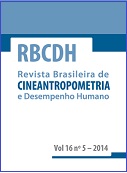Influence of running distance on plantar pressure
DOI:
https://doi.org/10.1590/1980-0037.2014v16n5p563Abstract
Running is a popular sport performed at different places and involving different distances and modalities. Long distance running promotes cumulative loading on joints and soft tissues that could determine important biomechanical alterations. A tool for assessing such loads is the measurement of plantar pressure. Here we compared static plantar pressure before and after 10 km and 21 km running competitions. Twenty trained runners participated in this study. They were assigned to 10 km (n=10) or 21 km (n=10) group according to their competition distance. Static plantar pressure was assessed in the day before competition and quickly after competition finished. Mean plantar pressure was compared between pre and post competition, between groups, legs and foot regions. Static plantar pressure did not differ between feet in either groups. In 10 km runners, higher plantar pressure post competition was observed in the forefoot, while any changes were observed in the 21 km group. Differences in plantar pressure between foot regions were similar between groups. In summary, static assessment of plantar pressure seemed more sensitive to changes in plantar pressure after a 10 km running, but not after 21 km. After 10 km running, forefoot experiences higher plantar pressure.



